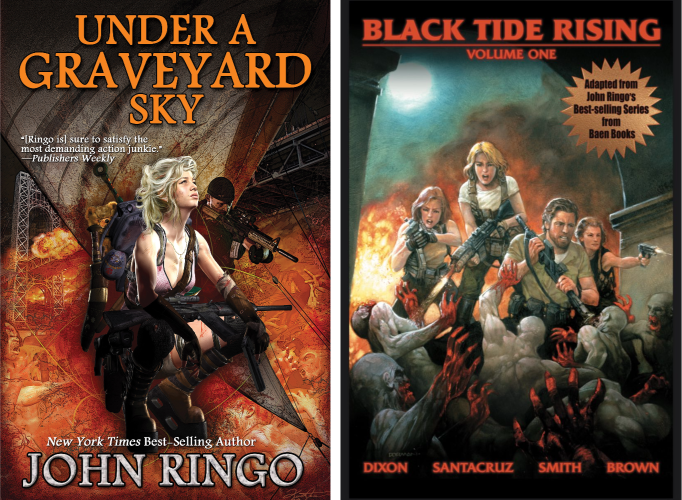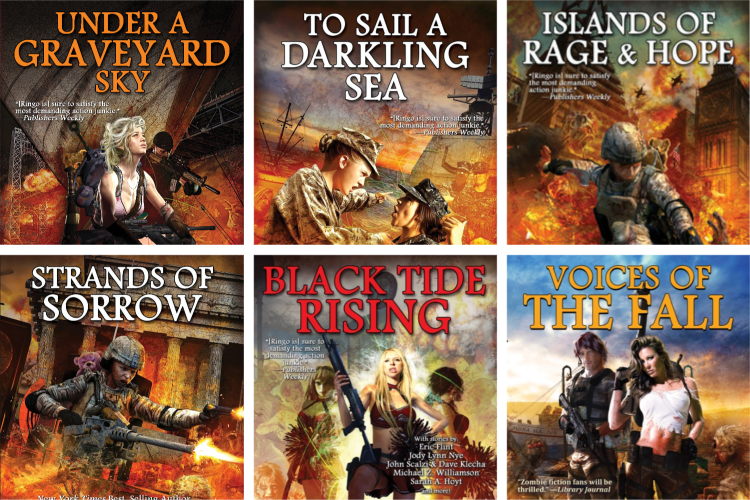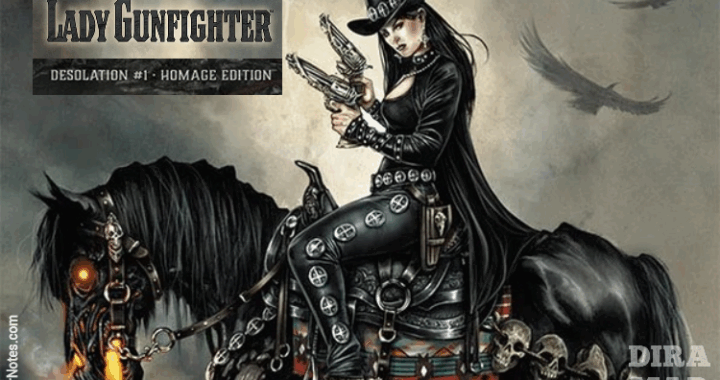
NOTES ON UNDER A GRAVEYARD SKY
A zombie outbreak is rapidly dismantling civilization, and the terrifying truth is—zombies are real. Worse yet, we created them! Are you ready for the zombie apocalypse? The Smith family certainly is.
After sharing my notes on the graphic novel Black Tide Rising Vol.1 I received feedback from fans of this universe that made me curious about the 2013 novel it is based on, Under a Graveyard Sky” by John Ringo. The novel is the first installment in the “Black Tide Rising” series, a gripping tale of a world plunged into chaos by a zombie apocalypse.
Known for his military science fiction, Ringo brings his expertise to the horror genre, blending action, strategy, and survival in a story that stands out among zombie fiction. The novel was first printed in 2013, the first mass paperback printing was in 2014. The copy I got was from the fifth mass paperback printing of 2022.
This article will focus on the novel and the comparisons of the two mediums. The structure of the notes will be a little different than usual and maybe a bit more extensive. But if you’ve been here before you know that already. Enjoy the reading!
THE STORY
The story is told in two chapters starting with “Book One: Light A Candle”.
The Smith family is forewarned about a pending bioterrorist attack by Tom Smith, a key figure in corporate security and a family member with insider knowledge. The bioterrorism event quickly spirals into a full-blown zombie pandemic, and the Smith family, led by the pragmatic and resourceful father, Steve Smith, takes immediate action to survive.
The plot primarily follows Steve, his wife Stacey, and their two daughters, Sophia and Faith, as they transition from suburban life to high-seas survivalists. The family secures a boat and plans to escape the worst of the outbreak by living at sea.
The second chapter “Book Two: I Will Not Bow” tells the story of how the family faces not only the relentless threat of the infected but also the challenges of sustaining life on the ocean and rescuing other survivors.
THE CHARACTERS
Steve Smith: A former Marine and a practical survivalist, Steve is a strong protagonist whose military background and level-headedness make him a natural leader in the crisis. His character is well-developed, showcasing a blend of toughness and deep familial love.
Faith Smith: Steve’s younger daughter, who becomes a standout character in the series. Her transformation from a typical teenager to a fierce and capable warrior is both compelling and believable, driven by necessity and her father’s training.
Sophia Smith: The elder daughter, more cerebral and cautious, provides a counterbalance to her sister. Sophia’s contributions are crucial to the family’s survival, demonstrating the importance of brains as well as brawn in a survival scenario.
Stacey Smith: While less central in the action compared to her husband and daughters, Stacey’s character offers emotional depth to the family dynamic, grounding the story with her maternal perspective and resilience.

THE THEMES
The novel explores themes of survival, family, and the collapse of civilization. It delves into the psychological and emotional toll of living through an apocalyptic event, as well as the moral dilemmas faced when societal norms are stripped away. Ringo also examines the role of leadership and the different forms it can take, particularly in crises. Here is a detailed breakdown of these themes:
SURVIVAL
Practical and Tactical Survival: The novel provides a meticulous look at the logistics and strategies required to survive a zombie apocalypse. From the initial preparations to securing a boat and planning for long-term sustainability at sea, the narrative covers various survival techniques. This includes dealing with limited resources, maintaining safety, and adapting to new threats. Ringo’s detailed descriptions emphasize the importance of preparedness, resourcefulness, and adaptability in extreme situations.
Psychological Survival: Beyond the physical aspects, the novel also explores the psychological challenges of surviving in a collapsed world. The characters face constant stress, fear, and the trauma of witnessing widespread death and destruction. Their mental resilience is tested as they grapple with the loss of loved ones and the constant threat of danger.
FAMILY
Strength of Family Bonds: The Smith family’s unity and cooperation are central to their survival. The novel highlights how their strong familial ties provide emotional support and motivation. Each family member contributes uniquely to their collective survival efforts, showcasing the importance of teamwork and mutual trust within a family unit.
Individual Growth within the Family: The characters, particularly the Smith daughters, undergo significant personal growth. Faith transforms from a typical teenager into a capable fighter, while Sophia’s intellectual contributions become crucial. This evolution underscores the theme of individual potential blossoming in response to crisis, supported by family encouragement.
THE COLLAPSE OF CIVILIZATION
Breakdown of Social Order: The novel vividly portrays the disintegration of societal structures as the zombie virus H7D3 spreads. Law enforcement, government, and social services collapse, leading to chaos and anarchy. This theme is explored through the character’s interactions with other survivors and the challenges of navigating a world where traditional social norms no longer apply.
Moral and Ethical Dilemmas: With the collapse of civilization, characters face numerous moral quandaries. Decisions about who to help, when to take risks, and how to balance personal safety with altruism become central to the story. These dilemmas highlight the complexities of maintaining one’s humanity in the face of overwhelming adversity.
LEADERSHIP
Different Forms of Leadership: The novel examines various leadership styles through its characters. Steve Smith’s military background equips him with a decisive and strategic approach, while other characters demonstrate leadership through compassion, intelligence, and moral integrity. The story illustrates that effective leadership can take many forms, especially in crisis situations.
Challenges of Leadership in Crisis: Leadership in the novel is portrayed as fraught with challenges. Leaders must make tough decisions, often with limited information and under extreme pressure. The novel explores the burden of leadership and the toll it takes on those who must guide others through perilous times.
ADAPTATION AND RESILIENCE
Adapting to New Realities: The characters’ ability to adapt to rapidly changing circumstances is a recurring theme. This involves not only physical adaptation, such as learning new survival skills, but also mental and emotional flexibility. The Smith family’s journey demonstrates that resilience and adaptability are key to enduring prolonged crises.
Innovation in Adversity: The novel also celebrates human ingenuity and innovation in the face of disaster. The characters often come up with creative solutions to survive, reflecting the theme that necessity drives invention and that even in dire situations, the human spirit can find ways to overcome obstacles.
“Under a Graveyard Sky” is rich with themes that explore survival, family, societal collapse, leadership, and resilience. Each theme is intricately developed through the characters’ experiences and the challenges they face, providing a multifaceted narrative that goes beyond typical zombie apocalypse fiction. These themes collectively underscore the novel’s exploration of human endurance and adaptability in the face of existential threats.
THE WRITING STYLE
The story reveals a realistic approach to survival, strong character development, engaging action, innovative setting, technical detail overload, and pacing issues.
- Realistic Approach to Survival: Ringo’s portrayal of the logistics and strategies needed to survive a zombie apocalypse is meticulously researched and highly plausible.
- Strong Character Development: The Smith family is well fleshed out, with each member undergoing significant growth and change in response to their circumstances.
- Engaging Action: The novel’s action scenes are intense and vividly described, keeping readers on the edge of their seats.
- Innovative Setting: The choice to set much of the story on the high seas is unique in zombie fiction and adds an extra layer of intrigue and danger.
- Familiar dialogue: much of the situations and things said feel familiar like the known corruption and the many situations happening during the pandemic like the hoarding of toilet paper.
“Bankers didn’t have to have their employees, kill, defame, or otherwise destroy enemies. There were lots of people, that just did it for them because, well, people wanted their money.
-Thomas “Train” Smith –
“When a new dam was being negotiated in some developing country, it wasn’t the banks who paid “laborers” to go beat up “protestors”. That was the local government that was going to make money off of the dam.
-Thomas “Train” Smith –
- Technical Detail Overload: Some readers might find the extensive technical and tactical details overwhelming or distracting from the story but some of it feels like déjà vu
“We Could build a protein sequence mimicking the binding sites for that“
– Dr. Curry –
- Pacing Issues: While generally fast-paced, there are sections where the narrative slows down, particularly during long descriptions of survival preparations.
NOVEL VS GRAPHIC NOVEL
In my view, the novel Under a Graveyard Sky by John Ringo and the graphic novel Black Tide Rising Volume 1, written by Chuck Dixon, both explore a zombie apocalypse but do so through different formats and unique storytelling styles. Here are some key differences between the two:
MEDIUM
“Under a Graveyard Sky” (Novel): This is a traditional prose novel, which allows for extensive internal monologues, detailed descriptions, and deep character development. The narrative unfolds through descriptive text, which can delve into the minutiae of the characters’ thoughts, surroundings, and actions.
“Black Tide Rising Volume 1” (Graphic Novel): This adaptation is presented in a visual format, combining text with illustrations. The graphic novel relies heavily on visual storytelling, using artwork to convey action, emotion, and setting. Dialogues and captions are used to complement the visual narrative.

STORYTELLING STYLE
Novel: The prose allows for a slower, more detailed exploration of the plot, characters, and themes. Readers get to experience the internal thoughts of the characters and can spend more time understanding their motivations and reactions.
Graphic Novel: The visual nature of the medium means that much of the storytelling is done through images. This can make the story more immediate and dynamic but often requires condensing the narrative and focusing on key scenes and dialogues.
TARGET AUDIENCE
Novel: Appeals to readers who enjoy detailed, immersive narratives and have the patience for a slower, more comprehensive storytelling style.
Graphic Novel: Attracts readers who prefer a visually-driven, fast-paced story, and those who appreciate the blend of text and art to convey a narrative.
THE STORY
Novel: The novel focuses on the detailed narrative of the Smith family navigating a world ravaged by a bioengineered zombie virus. John Ringo’s writing delves deeply into character development, intricate plot details, and the technical aspects of survival in a pandemic-ridden world. The prose allows for a thorough exploration of the character’s internal struggles and the overarching societal collapse, offering readers an immersive and comprehensive experience of the storyline.
Graphic Novel: Adapted by Chuck Dixon with art by Derlis Santacruz, the graphic novel condenses the novel’s plot, focusing on the most action-packed and visually dynamic elements. There are some adaptations to the original story and the timing of the release would make you think they made a story about covid but the novel predated the event.
The graphic novel format emphasizes visual storytelling, with illustrations bringing the horror and intensity of the zombie outbreak to life. The adaptation highlights key scenes and character interactions, providing a fast-paced and engaging experience for readers who prefer visual media.
DEPTH OF DETAIL
Novel: John Ringo’s novel includes extensive detail about survival tactics, the breakdown of society, and the intricacies of the Smith family’s planning and execution of their escape. The novel can spend pages on a single aspect of survival, providing a comprehensive understanding.
Graphic Novel: Due to the constraints of the medium, the graphic novel often streamlines these details and presents them a bit differently. While key survival elements and plot points are included, they are typically presented more succinctly, with the focus shifting to visual dramatization of events.
CHARACTER DEVELOPMENT
Novel: The character development is thorough, with readers gaining insight into the characters’ backgrounds, thoughts, and emotional journeys. The Smith family’s dynamics and individual growth are explored in depth.
Graphic Novel: Character development is more visually driven. Expressions, body language, and concise dialogues are used to convey character traits and development. This can make characters seem less complex compared to their novel counterparts but more immediate and visually engaging.
ACTION AND PACING
Novel: The pacing varies, with intense action scenes interspersed with slower, more reflective moments. This variation allows for a build-up of tension and a deeper emotional impact.
Graphic Novel: The pacing tends to be faster, driven by the need to keep the visual narrative engaging. Action scenes are prominent and depicted vividly, often occupying several pages to capture the intensity and motion.
VISUALIZATION
Novel: Readers visualize the story through their imagination, guided by Ringo’s descriptive writing.
Graphic Novel: The story is brought to life through the artist’s interpretation, providing a specific visual representation of characters, settings, and events such as tense atmosphere and dynamic action scenes. This can enhance the reader’s experience by offering a concrete visual context but can also limit the imagination compared to reading prose.
EMOTIONAL IMPACT
Novel: The emotional impact is built gradually through detailed narrative and internal monologues.
Graphic Novel: The emotional impact is often more immediate, conveyed through expressive artwork and dramatic scenes.
FINAL THOUGHTS
“Under a Graveyard Sky” is a standout entry in the zombie apocalypse genre, offering a fresh perspective with its focus on realistic survival strategies and strong family dynamics.
John Ringo’s military expertise enriches the narrative, providing an authentic and immersive experience. The dialogue is sharp, often laced with dark humor, and the characters’ interactions feel realistic and engaging. Fans of action-packed, strategic survival stories will find this novel an engaging and satisfying read. While it may occasionally delve too deeply into technical details, the overall story remains compelling and well worth the read.
Additionally, while the novel offers extensive background, detailed scenarios, and even a playlist of songs including the song considered the anthem of the series, the graphic novel adaptation streamlines the story, making it accessible to a broader audience, including those new to the “Black Tide Rising” series like myself. This approach allows for a different engagement with the story, where visual elements complement the narrative, potentially attracting readers who might not typically pick up a novel.

After reading the graphic novel first and receiving feedback about my insights it was clear that this is a well-established universe with an extremely loyal fanbase, the feedback and conversations were very interesting and made me even more curious about how the story originally started. One thing that I can’t shake off regarding both versions is the strong feeling of déjà vu from the COVID-19 pandemic era: from the toilet paper hoarding, the creation of the virus, the corruption, misuse of power, etc., etc. It looks like new readers have a different reading experience than older readers.
Overall, while both the novel and the graphic novel share the same foundation, they cater to different preferences: the novel for those who enjoy detailed, in-depth storytelling, and the graphic novel for those who appreciate visual and condensed narratives. But the story doesn’t end here, the novel series continues with “To Sail a Darkling Sea”, “Islands of Rage and Hope”, “Strands of Sorrow”, “Black Tide Rising” and “Voices of the Fall.” And the Graphic Novel series will continue with Black Tide Rising Vol.2., currently funding on Indiegogo.
My Rating: 8/10
Interested?
Find the Novels on Baen Books, Amazon, Barnes and Noble, Simon & Schuster
Find the Graphic novel Black Tide Rising Vol.1 on Baen Books, Amazon, and many other stores
Fund the making of the Graphic Novel Black Tide Rising Vol.2 on Indiegogo
My notes are all set. Let me know what you think.
See you on the next page!




Thank you for your review! I am a loyal fan of both. Spread the word, light a candle!
Hi Lee,
That’s great! Glad you enjoyed it:)